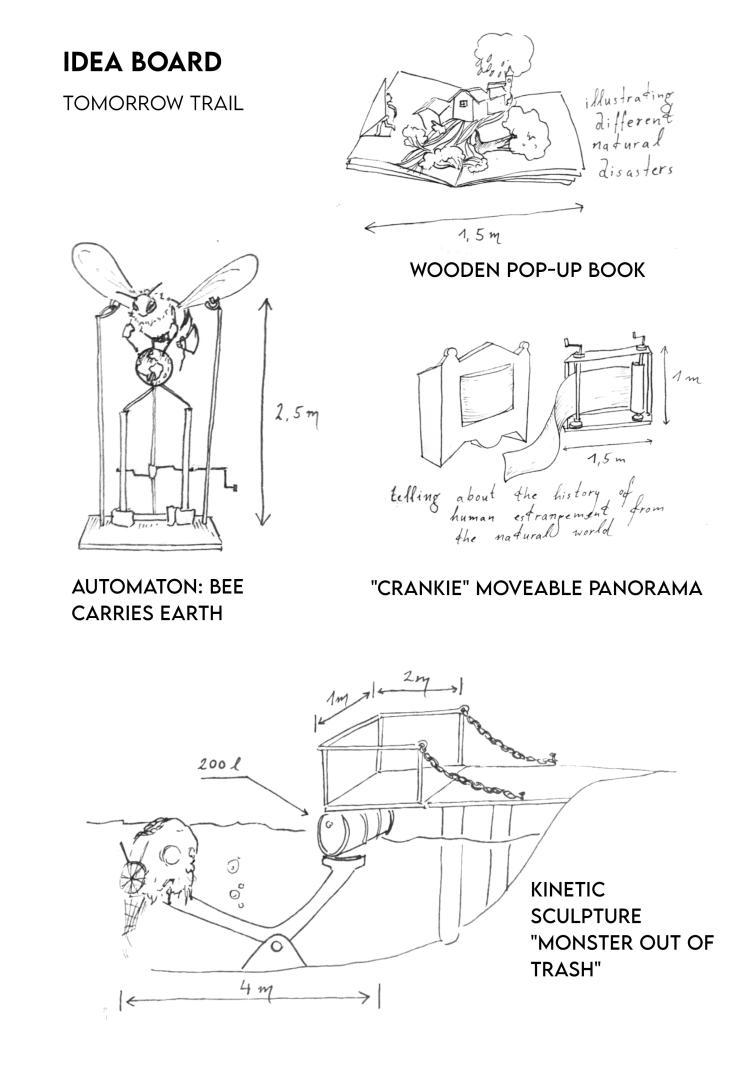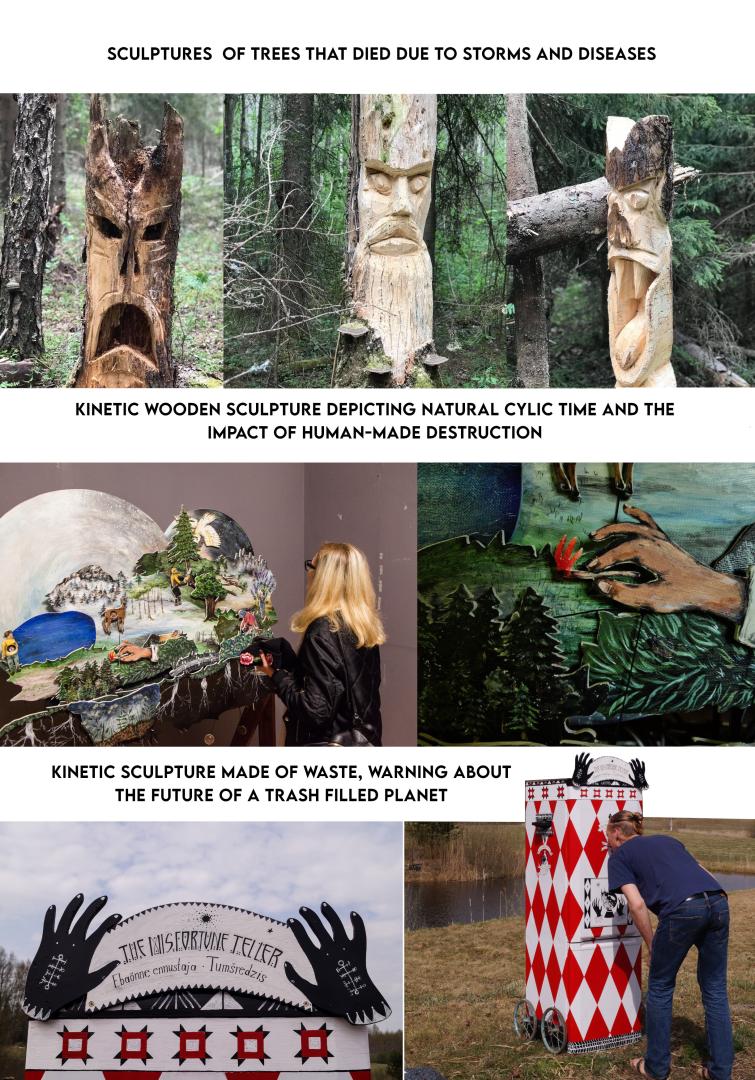Tomorrow Trail
Basic information
Project Title
Full project title
Category
Project Description
Tomorrow Trail is a heroic treasure hunt landscape game consisting of interactive landmarks that lead the audience through the anthropocentric history of mankind and its consequences.
Based in rural Northern Latvia, individuals and groups will be able to observe the questions of where it all went wrong and will have to decide which path they will choose to walk.
Geographical Scope
Project Region
Urban or rural issues
Physical or other transformations
EU Programme or fund
Which funds
Description of the project
Summary
On the ground of the Open Homestead Zadiņi in Northern Latvia, the development of an interactive landscape game for visitors that takes 1 – 1,5h to visit has been started.
The project plan includes a set of 10 main landmarks and several smaller installations that will stimulate the viewer's sense of engaging in a reciprocal, responsible relationship with the environment.
Installed along a walking path, the landmarks will consist of a variety of styles: wooden sculptures, interactional land art, natural architecture, kinetic sculptures and painted moving panoramas that tell about the alienation of humans from the natural cyclic systems.
This “treasure hunt for conscious choices” will address the history of anthropocentric overconsumption and with it both the past and current roles of individuals as well as the massive contribution of global corporate giants. The works will include themes of industrial livestock farming, pesticides and soil impoverishment, waste, the decline of insects, mammals and fish, deforestation, consumption and a general lack of connection to other-than-humans.
The last landmark on the path will ask the audience to make a choice where they would want to continue the path: To a landmark that shows a Dystopian vision of an exploited Earth, or to a path that points out ways of reacting to the trouble: a hopeful, empowering route that portrays possible solutions, such as supporting local trade and growth, eating consciously, reducing waste, developing a caring relationship with nature etc.
Having to go through a journey of trials, errors, and absolution, the visitor will get a clear picture of the impact that our industrialised societies have on Earth, and the responsibility to accept an urgent behavioural change.
Key objectives for sustainability
In the wider context of Eastern Europe, Latvia holds an interesting position. Approximately 40 per cent of the country is still forested, almost every one knows how to forage wild foods and plant a garden, and due to a long history of occupation and endured financial crises, Latvians cherish a proud but open-minded patriotism.
Yet, their talents of resilience, self-sustainability and local bonds are not being put in the global context of the unravelling social and environmental collapse. Creating pieces of art that would enhance an interest in connecting these skills with modern politics would benefit the locals as much as international neighbours and other former USSR states that share a similar history.
If more Latvians would get stimulated in taking pride in their rural upbringing, they would
a) take action in preserving their forests and investing in re-plantation;
b) become an example for other Eastern European countries of not having to follow the "Western way" of possessing and throwing away;
c) take an interest in returning to the rural landscapes to minimise the demography change.
The uniqueness of the project lies at linking rural heritage with the wider aspects of global warming and playfully encouraging the audience towards action. In this way we go from local to global and back to a personal approach, making the interconnection between our actions visible.
Key objectives for aesthetics and quality
Learning about sustainability in non-formal educational set-ups, such as outdoor classrooms, are often lacking the aesthetic elements that would help those engage, who do not happen to have an intrinsic interest in the environment. Additionally, many educational programmes about the climate crisis are aimed at shocking and scaring the audience, as it is seen in several NGO campaigns.
The project Tomorrow Trail intends to prove that non-formal education that counts on beauty, play, adventure and stories can be a far more effective approach towards making people change their inherent relationship towards nature.
The concept of the trail is based on the idea that each visitor undertakes a hero's journey on which they can ultimately make decisions that lead to beneficial change. Walking the path and concluding a set of tasks at each landmark should be a fun and adventurous experience that lasts in their memories. It is through play that our learning abilities accelerate and the set up will enable a playful identification with being someone whose actions matter.
Key objectives for inclusion
In Latvia in general but explicitly in the rural areas it is very hard for more marginalised groups of people to get access to non-formal education, as well as cultural offers and leisure time activities. To learn about and live sustainably is reserved for the more privileged.
The idea of the landscape game Tomorrow Trail is to provide education, fun, inspiration and empowerment for people of all social classes. The possible steps one can choose to take towards a sustainable future that are presented within the game are not limited to the wealthy, but are rather based on the concept of degrowth and returning to simplicity and reducing our purchases.
The path will not contain any major obstacles, so that people with walking handicaps, baby carriers, older people, and pregnant women can join. Some landmarks will also be reachable by wheel-chair, but as we adjust the trail to the natural landscape, not all parts will be accessible.
The trail will be promoted as a family-friendly activity for people of all ages. It is not profit orientated, even though we will give visitors the possibility to donate for eventual repair works and enlarging the installation.
The project is based on the land of the Permaculture community homestead "Zadiņi". While the trail has one main designer, the collective intelligence of the other community members helps at co-creating the art works. Together, we will critically access the sources of all the information that will be provided. As an example, while researching the different stages in history it will be important to seek for data that does not only mirror history written by men, but also the reality of women back in time.
Physical or other transformations
Innovative character
The three pillars of the project are:
- creating an educational landscape game in form of a walking path
- adding playful, interactive objects that stimulate different senses in the audience
- making it available for people from all social classes to give access to education of sustainable ways of living despite of one's financial possibilities
The three dimensions - environmental sustainability, aesthetic content, social inclusion- interact with each other and together form an idea that could potentially change the face of the whole district.


